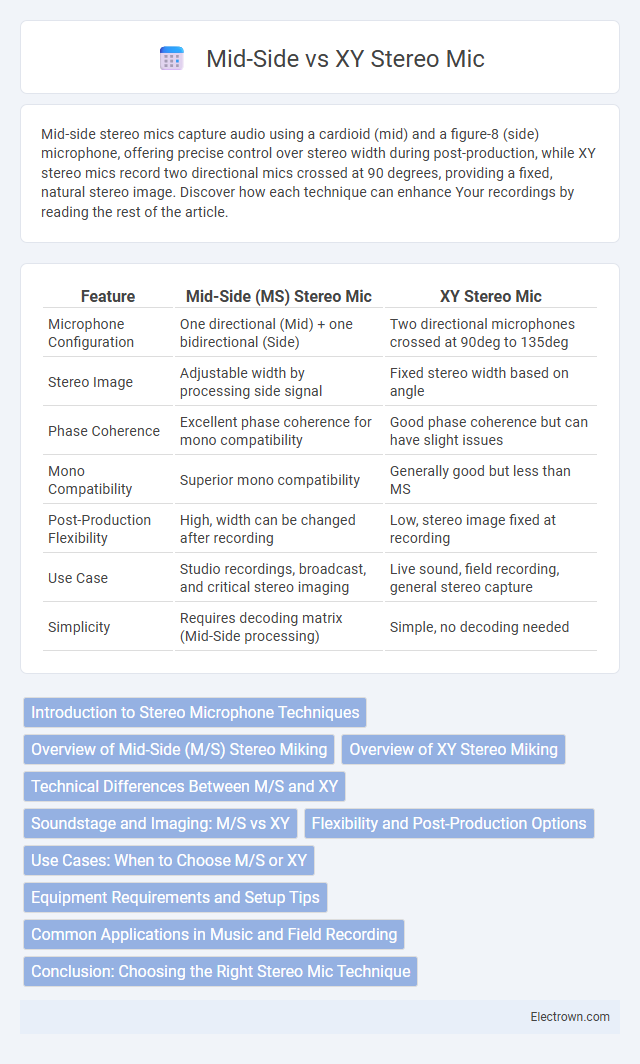Mid-side stereo mics capture audio using a cardioid (mid) and a figure-8 (side) microphone, offering precise control over stereo width during post-production, while XY stereo mics record two directional mics crossed at 90 degrees, providing a fixed, natural stereo image. Discover how each technique can enhance Your recordings by reading the rest of the article.
Table of Comparison
| Feature | Mid-Side (MS) Stereo Mic | XY Stereo Mic |
|---|---|---|
| Microphone Configuration | One directional (Mid) + one bidirectional (Side) | Two directional microphones crossed at 90deg to 135deg |
| Stereo Image | Adjustable width by processing side signal | Fixed stereo width based on angle |
| Phase Coherence | Excellent phase coherence for mono compatibility | Good phase coherence but can have slight issues |
| Mono Compatibility | Superior mono compatibility | Generally good but less than MS |
| Post-Production Flexibility | High, width can be changed after recording | Low, stereo image fixed at recording |
| Use Case | Studio recordings, broadcast, and critical stereo imaging | Live sound, field recording, general stereo capture |
| Simplicity | Requires decoding matrix (Mid-Side processing) | Simple, no decoding needed |
Introduction to Stereo Microphone Techniques
Mid-side and XY stereo microphone techniques capture spatial audio differently to create immersive soundscapes. Mid-side uses a cardioid mic facing forward paired with a bidirectional mic capturing side information, allowing precise control over stereo width in post-production. Your choice depends on recording environment and desired flexibility, with mid-side offering adjustable stereo imaging and XY providing a fixed, phase-coherent stereo field.
Overview of Mid-Side (M/S) Stereo Miking
Mid-Side (M/S) stereo miking captures sound using one directional mid microphone and one bidirectional side microphone, providing precise control over stereo width during post-production. This technique allows you to adjust the balance between the mid and side signals, enhancing flexibility in mixing and ensuring consistent mono compatibility. M/S recording offers a compact microphone setup ideal for capturing a natural soundstage with excellent spatial accuracy.
Overview of XY Stereo Miking
XY stereo miking utilizes two directional microphones positioned at a 90 to 135-degree angle with capsules as close together as possible, capturing a coherent stereo image with minimal phase issues. This technique emphasizes spatial accuracy, providing a natural and stable soundstage primarily by relying on level differences between the left and right signals. XY is especially effective for ensemble recordings and live sound where precise localization and minimal microphone bleed are essential.
Technical Differences Between M/S and XY
Mid-Side (M/S) stereo microphone technique uses one directional (mid) mic and one figure-eight (side) mic to capture sound, allowing independent control over stereo width during mixing. XY stereo employs two cardioid microphones placed at a 90-135deg angle with capsules close together, combining signals to create a fixed stereo image based on time and amplitude differences. M/S provides greater flexibility and mono compatibility, while XY offers simplicity and phase coherence without requiring matrix decoding.
Soundstage and Imaging: M/S vs XY
Mid-Side (M/S) stereo miking offers superior control over stereo width and precise soundstage manipulation by adjusting the mid and side signals independently, resulting in a more natural and flexible spatial image. XY stereo configuration captures phase-coherent audio with fixed stereo width, delivering a stable but less adjustable soundstage and imaging. M/S is preferred for environments requiring post-recording stereo image control, while XY suits consistent, straightforward stereo capture.
Flexibility and Post-Production Options
Mid-side stereo mics offer superior flexibility and post-production options by allowing independent control of the mid and side signals, enabling precise adjustment of stereo width and balance after recording. XY stereo mics, while providing a stable and phase-coherent stereo image, lack the ability to modify the stereo field dynamically during mixing. This makes mid-side techniques ideal for situations where adaptability and fine-tuning in post-production are critical.
Use Cases: When to Choose M/S or XY
Mid-side (M/S) stereo mics excel in environments requiring precise control over stereo width during mixing, such as film dialogue or acoustic instrument recording. XY stereo mics are ideal for live performances and on-the-go recording, offering a natural stereo image with minimal phase issues and easy setup. You should choose M/S when post-production flexibility is essential, while XY suits straightforward, consistent capture scenarios.
Equipment Requirements and Setup Tips
Mid-side stereo miking requires a cardioid (mid) microphone and a figure-8 (side) microphone, along with a mid-side decoder or compatible audio software for processing. XY stereo involves two matched cardioid microphones placed at a 90 to 135-degree angle, capturing a natural stereo image with simpler setup and no decoding needed. To optimize your setup, ensure precise microphone placement and alignment to achieve accurate phase coherence for mid-side, while XY demands careful angle adjustment and consistent spacing to preserve stereo balance.
Common Applications in Music and Field Recording
Mid-side (MS) stereo mics are widely used in music production and field recording for their versatility in capturing a balanced stereo image with adjustable width, making them ideal for live performances and ambient soundscapes. XY stereo mics excel in preserving accurate stereo localization and phase coherence, often preferred for close-miked instruments and on-location recordings requiring minimal post-processing. Choosing between MS and XY setups depends on your need for flexibility in post-production versus natural stereo realism in the captured audio.
Conclusion: Choosing the Right Stereo Mic Technique
Mid-side stereo mics offer precise control over stereo width during mixing, making them ideal for flexible post-production adjustments and capturing a balanced, natural soundstage. XY stereo mics provide a consistent, phase-coherent stereo image with simpler setup, perfect for live recordings where minimal editing is preferred. Your choice depends on whether you need versatility in mixing (mid-side) or straightforward, reliable stereo capture (XY).
mid-side vs xy stereo mic Infographic

 electrown.com
electrown.com